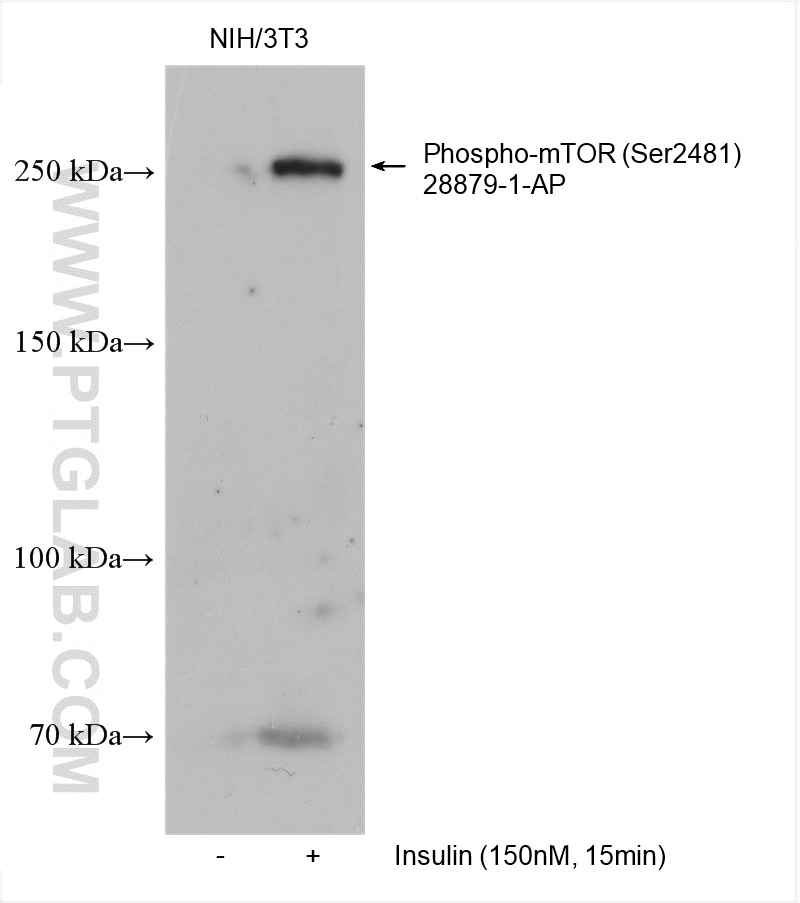Anticorps Polyclonal de lapin anti-Phospho-mTOR (Ser2481)
Phospho-mTOR (Ser2481) Polyclonal Antibody for WB, ELISA
Hôte / Isotype
Lapin / IgG
Réactivité testée
souris et plus (2)
Applications
WB, ELISA
Conjugaison
Non conjugué
N° de cat : 28879-1-AP
Synonymes
Galerie de données de validation
Applications testées
| Résultats positifs en WB | cellules NIH/3T3 traitées à l'insuline |
Dilution recommandée
| Application | Dilution |
|---|---|
| Western Blot (WB) | WB : 1:500-1:1000 |
| It is recommended that this reagent should be titrated in each testing system to obtain optimal results. | |
| Sample-dependent, check data in validation data gallery | |
Applications publiées
| WB | See 11 publications below |
Informations sur le produit
28879-1-AP cible Phospho-mTOR (Ser2481) dans les applications de WB, ELISA et montre une réactivité avec des échantillons souris
| Réactivité | souris |
| Réactivité citée | rat, Humain, souris |
| Hôte / Isotype | Lapin / IgG |
| Clonalité | Polyclonal |
| Type | Anticorps |
| Immunogène | Peptide |
| Nom complet | FK506 binding protein 12-rapamycin associated protein 1 |
| Masse moléculaire calculée | 289 kDa |
| Poids moléculaire observé | 250-289 kDa |
| Numéro d’acquisition GenBank | BC117166 |
| Symbole du gène | mTOR |
| Identification du gène (NCBI) | 2475 |
| Conjugaison | Non conjugué |
| Forme | Liquide |
| Méthode de purification | Purification par affinité contre l'antigène |
| Tampon de stockage | PBS with 0.02% sodium azide and 50% glycerol |
| Conditions de stockage | Stocker à -20°C. Stable pendant un an après l'expédition. L'aliquotage n'est pas nécessaire pour le stockage à -20oC Les 20ul contiennent 0,1% de BSA. |
Informations générales
MTOR, also named FRAP1, FRAP, FRAP2, and RAPT1, belongs to the PI3/PI4-kinase family. MTOR is a Ser/Thr protein kinase that functions as an ATP and amino acid sensor to balance nutrient availability and cell growth. MTOR is the kinase subunit of both mTORC1 and mTORC2, which regulate cell growth and survival in response to nutrient and hormonal signals. mTORC1 is activated in response to growth factors or amino acids. mTORC2 is also activated by growth factors but seems to be nutrient-insensitive. mTORC2 seems to function upstream of Rho GTPases to regulate the actin cytoskeleton, probably by activating one or more Rho-type guanine nucleotide exchange factors. mTORC2 promotes the serum-induced formation of stress fibers or F-actin. mTOR is phosphorylated at Ser2448 via the PI3 kinase/Akt signaling pathway and autophosphorylated at Ser2481. mTOR plays a key role in cell growth and homeostasis and may be abnormally regulated in tumors.
Protocole
| Product Specific Protocols | |
|---|---|
| WB protocol for Phospho-mTOR (Ser2481) antibody 28879-1-AP | Download protocol |
| Standard Protocols | |
|---|---|
| Click here to view our Standard Protocols |
Publications
| Species | Application | Title |
|---|---|---|
Anal Cell Pathol (Amst) Shikonin Induces Autophagy and Apoptosis in Esophageal Cancer EC9706 Cells by Regulating the AMPK/mTOR/ULK Axis | ||
Am J Transl Res Integrating network pharmacology with experimental validation to investigate the mechanism of Wuwei Zishen formula in improving perimenopausal syndrome | ||
Naunyn Schmiedebergs Arch Pharmacol Network pharmacology-based strategy to reveal the mechanism of pinocembrin against ovarian cancer | ||
Sci Rep Morphine promotes non-small cell lung cancer progression by downregulating E-cadherin via the PI3K/AKT/mTOR pathway | ||
Int J Biol Macromol Lactoferrin ameliorates cognitive impairment in D-galactose-induced aging mice by regulating the PI3K/Akt/mTOR signaling pathway and the microbiome-gut-brain axis | ||
Eur J Neurosci Oleracein E Rejuvenates Senescent Hippocampal NSCs by Inhibiting the ERK1/2-mTOR Axis to Improve Cognitive Dysfunction in Vascular Dementia |


